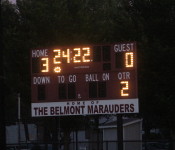Photo: Belmont High Field Hockey’s co-captains Serena Nally (l) and Molly Thayer (r) and junior AnnMarie Habelow (center).
Belmont High School’s Field Hockey team lost a boatload of seniors to graduation from last year’s 11-4-2 squad, starting the 2015 season with a defense corp of underclassmen learning how to play as a cohesive unit.
So you would expect the Marauders to be treading water in the competitive Middlesex League Liberty Division during the first weeks of the new seasons.
But Head Coach Jessie Smith’s squad is doing just swimmingly. After another workmanlike victory Tuesday night, Sept. 22, a 7-0 win over Woburn, the Marauders have completed a third of the season undefeated at 5-0.
Just as impressive as its record is Belmont’s scoring prowess, slotting in an Eastern Massachusetts-leading 29 goals. Only one other team, Quaboag, has matched the Marauders’ proficient rate.
What gives?
“I sometimes ask that same question,” said Smith, who is entering her 13th season as head coach.
While Smith said the schedule has helped – only Wilmington, which Belmont dispatched quickly, 4-0, last week, has a .500 record – much of the early season’s success generates from a core of two- and three-year starters who’ve played together and know their way around a field hockey pitch.
That list starts with one of the most dominate players in Massachusetts (and the region) in junior midfielder AnnMarie Habelow on the pitch. The Division 1 Louisville-commit has been deadly within the shooting circle, sending whippet-like shots that scatter defenders and test goalies.
But Habelow is not merely a shooting machine. The three-year starter’s arsenal includes fast and accurate passes, the skills to weave through defenders like Mikaela Shiffrin heading down a hill and the ability to lift the ball over a line of midfielders to clear the area and change the flow of play.

Joining Habelow in the attack is senior forward Kerri Lynch, who has tallied ten goals scoring in each game, and senior co-captain Serena Nally, who registered a brace Wednesday, as did Lynch and Habelow.
Youngsters are coming to the fore such as defender Lilly Devitt, midfield Bridget Gardiner and Morgan Chase (scoring a goal in each of last three games) joining veteran junior Julia Chase on the wings where they each have a deft touch with their sticks.
The key to the defense is senior co-captain Molly Thayer, who Smith has positioned as a sweeper. Thayer’s job is straight forward; use her speed and defensive skills to track down offensive player who gets by the defensive line and running down any attempt heading towards sophomore goalie Christina MacLeod.
“Molly plays a big role in every game. The defense doesn’t see much action, but that’s because she is stopping the plays before it gets to them,” said Smith.
That young backline – which includes Thayer, Devitt and Molly Goldberg – will be tested in the next two games as the Marauders host rivals 4-1 Lexington on Friday, Sept. 25 at 3:30 p.m. and a resurgent Winchester squad, at 5-1, in Winchester on Monday, Sept. 28.
“It will be interesting to see how our defense reacts to a very strong offense that we haven’t seen yet,” said Smith.





















































































